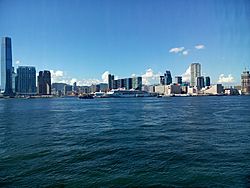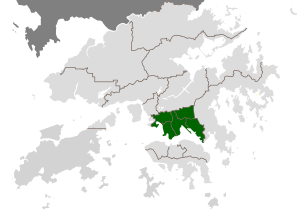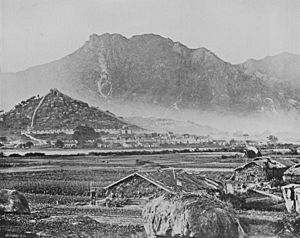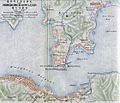Kowloon facts for kids
Quick facts for kids
Kowloon
|
|
|---|---|

Kowloon as viewed from Hong Kong Island
|
|
| Nickname(s):
Dragon City
|
|

Location within Hong Kong
|
|
| City | Kowloon |
| Area | |
| • Land | 67 km2 (26 sq mi) |
| Population
(2011)
|
|
| • Total | 2,108,419 (2.1 million) |
| • Density | 43,033/km2 (111,450/sq mi) |
| Time zone | UTC+8 (Hong Kong Time) |
Kowloon is an urban area in Hong Kong comprising the Kowloon Peninsula and New Kowloon. It is bordered by the Lei Yue Mun strait to the east, Mei Foo Sun Chuen and Stonecutter's Island to the west, a mountain range, including Tate's Cairn and Lion Rock to the north, and Victoria Harbour to the south. With a population of 2,019,533 (2 million) in 2006, it is the most populated urban area in Hong Kong.
History

The name Kowloon stems from the term nine dragons, because of eight mountains and a Chinese emperor: Kowloon Peak, Tung Shan, Tate's Cairn, Temple Hill, Unicorn Ridge, Lion Rock, Beacon Hill, Crow's Nest and Emperor Bing of Song.
The invasion of China by Japan in 1937 caused the population of Kowloon to explode. Between 1937 and 1939, 750,000 refugees arrived in Kowloon and nearby areas, with many being homeless. Kowloon became extremely congested when slums for refugees from the newly established China gave way to public housing estates, mixed with private residential, commercial and industrial areas.
Within New Kowloon is Kowloon City, an area of Hong Kong where the Kowloon Walled City used to be located. The Kowloon Walled City itself was demolished in 1993.
Large-scale development of Kowloon began in the early-20th century, with the construction of the Kowloon-Canton Railway and the Kowloon Wharf, but because of Kowloon's close proximity to Kai Tak Airport, building construction was limited by flight paths. As a result, compared to Hong Kong Island, Kowloon has a much lower skyline.
Images for kids
-
The Hong Kong Polytechnic University in Hung Hom
-
Night view of Kowloon from Hong Kong Island
See also
 In Spanish: Kowloon para niños
In Spanish: Kowloon para niños












